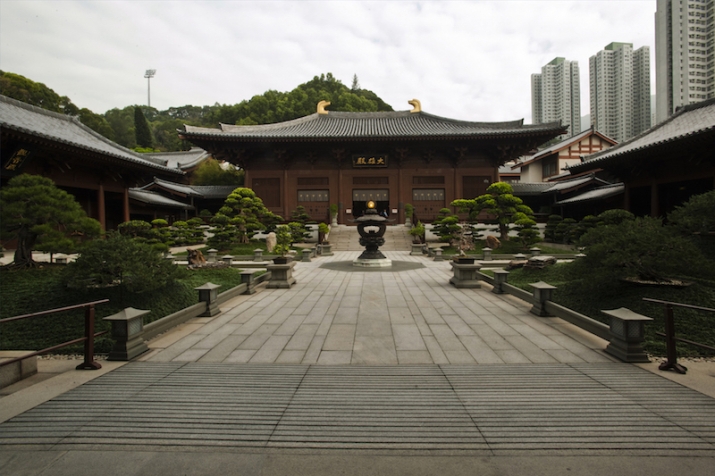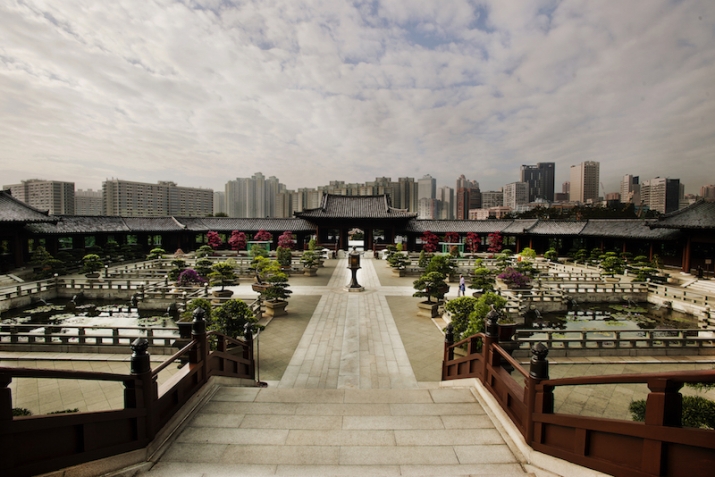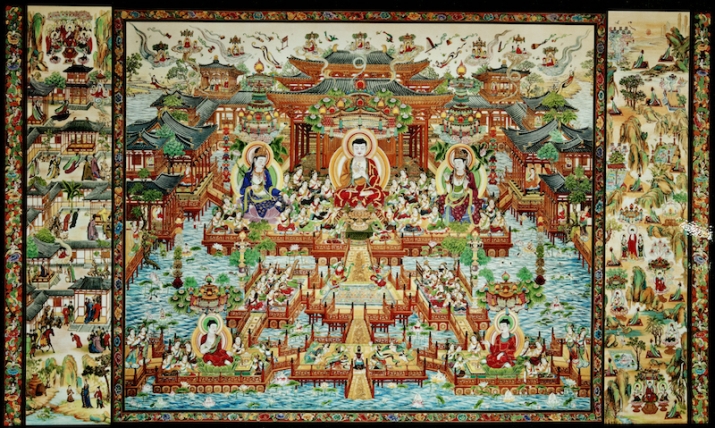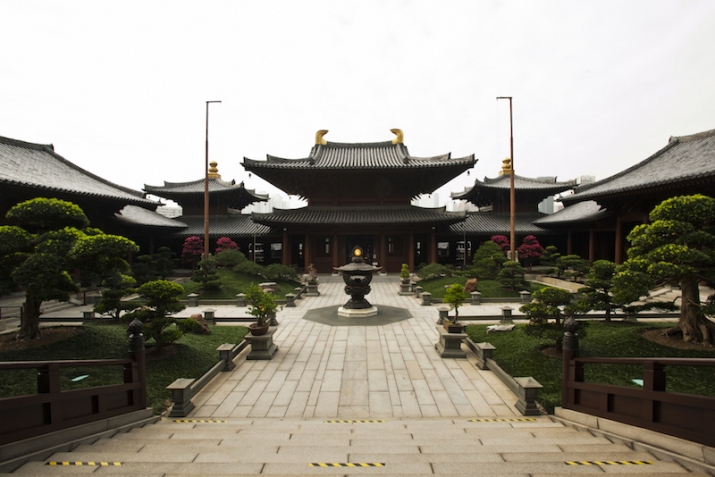FEATURES|THEMES|Art and Archaeology
Expressing the Pure Land through Art and Architecture—Chi Lin Nunnery
Buddhistdoor Global | 2015-01-16 |
 Second courtyard to the main hall. From Tim Liew
Second courtyard to the main hall. From Tim LiewFour years ago, one of my best friends visited Hong Kong. The first cultural landmark I took him to was Chi Lin Nunnery, which I believe is one of the city’s most attractive temples. It was the first time my friend had seen a faithful replica of Chinese Tang dynasty (618–907) architecture, and he recalls the occasion fondly at our reunions even now. I will never forget the last time I visited the complex with my now 92-year-old preceptor. His serene but almost childlike mien of joy while shuffling keenly among the sun-dappled trees and pillars will remain in my heart as long as I live.
I have never quite worked out why I so enjoy visiting Chi Lin. Perhaps it is simply on account of its architecture. The planning and construction are exquisite as well as authentic, with beautiful interlocking bracket sets that connect the temple columns with their roofs (dou gong), and intricately worked faces of mythical guardian beasts (shou mian) on the roof tiles. It might also be because I find the visual width of the temple halls and the breadth of their courtyards a pleasing contrast to the emphasis on depth and height in Catholic or Anglican churches.
 Chi Lin's first courtyard. From Tim Liew
Chi Lin's first courtyard. From Tim LiewAs the cliché goes, what’s hardest to spot is hiding right under your nose. Chi Lin is remarkable because it is, in principle, an architectural replica of Amitabha’s Pure Land itself—a three-dimensional representation of the High Tang paintings of 705–81 CE at Dunhuang’s Mogao Grottoes. Behind the shrine in Chi Lin’s main hall (Da xiong bao dian) is a replica of a mural from the southern wall of Cave 172. Such murals were meticulously painted to express the visions revealed in the Pure Land sutras, an artistic genre known as “transformation art” (jing bian tu).
Transformation art has antecedents in the jiang jing (sutra oratory) and guan xiang (visualization) literature produced for ritual participation, as noted in an informative essay by Wu Hung (Wu 1992, 55–6). Transformation art is based around the Contemplation Sutra and the story of Queen Vaidehi’s visualization of Amitabha’s Pure Land under the historical Buddha Shakyamuni’s tutelage. Indeed, this text’s description of the Pure Land became the principal image around which artists based their work.
There are differences in the paintings at Dunhuang, of course: artists are individual people with their own aesthetic preferences and cultural backgrounds. Even in Cave 172 itself, which alone features two Pure Land paintings, the southern wall, on which Chi Lin based its replica painting, depicts a Sinicized Amitabha with flowing robes, whilst the northern wall’s Amitabha has broad shoulders and a narrow waist with a bare torso, characteristics typical of Indian or Central Asian art (Wu 1992, 57).
We cannot say for certain why the Dunhuang cave artists were commissioned to paint this text in particular. Perhaps the Contemplation Sutra offered the most systematic imagery of Amitabha and the Pure Land, which by the High Tang had entered China and become popular objects of devotion. Another possibility might be that due to the caves’ function as a place for practice, it was preferable to select a text that purported to assist in visualization and meditation.
 Temple photo of the replica painting of the Pure Land at Chi Lin, in the main hall (used with permission). From Tim Liew
Temple photo of the replica painting of the Pure Land at Chi Lin, in the main hall (used with permission). From Tim LiewThe sutra offers one of the most difficult practices in Mahayana Buddhism: 13 increasingly complex stages of visualization, culminating in the manifestation of the Pure Land in the mind. At each stage, the previous ones are to be retained in the mind’s eye. The cave paintings are but guides to each individual’s intensely personal visualization practice. All in all, they provide an “easier” guide to the correct meditation than the intricate text of the Contemplation Sutra.
The artists, then, did not intend viewers to be passive recipients of their paintings, but active participants in the interpretation and absorption of the Pure Land art, here represented as a tripartite structure that was a popular artistic formula during the Tang. This structure consists of a dominant iconic image for devotional practice, a pictorial story, and a visual assistance for meditation (Wu 1992, 54). Here, the pictorial story is the sequential narrative of Prince Ajatasatru, beginning with his imprisonment of his parents, King Bimbisara and Queen Vaidehi, and culminating with Shakyamuni Buddha’s instructions to Queen Vaidehi to visualize the Pure Land. The visual assistance for meditation is the visualization in 13 stages outlined above, as practiced by Queen Vaidehi herself.
Chi Lin, however, goes one step further, serving as what could perhaps be called “transformation architecture.” The lotus ponds, placed symmetrically in the first courtyard after the shanmen (the first gate of the temple), are intended to remind us of the crystal water from which the Pure Land universe emerges, while the white marble pillars flanking the Hall of Heavenly Kings (Tianwang dian) recall the tower and pavilion imagery in transformation art.
 View of second courtyard from the main hall. From Tim Liew
View of second courtyard from the main hall. From Tim LiewNevertheless, Chi Lin’s temple complex does not mirror the Pure Land cave painting format completely. The main hall is dedicated to the Buddha Shakyamuni, and there are additional shrines for the Medicine Buddha (Skt. Bhaishajyaguru) and Guanyin (Skt. Avalokiteshvara), with beautiful, gold-leafed statues of the deities. There are also a drum tower to the west and bell tower to the east between the main hall and shanmen, which is more a cultural convention than faithfulness to sutra imagery. In practice, also, Chi Lin functions much in the same way as other contemporary Chinese Buddhist temples—to serve as a place of religious inspiration, solace, and spiritual growth.
Admittedly, it is difficult to convince even the most pious of visitors that they are penetrating the holy pavilions of Sukhavati. Transformation architecture is not a classifiable genre like jing bian—I doubt even the professional artists of Dunhuang in the High Tang could have imagined their grand visions of the Pure Land dwarfed by the high-rise housing blocks typical of Hong Kong. Chi Lin was not intended to simply reflect a specific period, like the Tang dynasty, or a particular place, like Dunhuang. Rather, it is supposed to provide a sense of the inconceivable peace revealed in the Pure Land sutras, in other words, the presence of Amitabha himself. We can catch an infinitesimal glimpse of this peace in the replica painting in the main hall. But through the three-dimensional structure of Chi Lin itself, we can cheekily allow ourselves to imagine our bodies, if ever so briefly and falsely, in paradise, concrete flyovers and skyscrapers notwithstanding.
References
Hung, Wu. 1992. “Reborn in Paradise: A Case Study of Dunhuang Sutra Painting and its Religious, Ritual and Artistic Context.” Orientations 23(5): 52–60.
References
Hung, Wu. 1992. “Reborn in Paradise: A Case Study of Dunhuang Sutra Painting and its Religious, Ritual and Artistic Context.” Orientations 23(5): 52–60.

Comments:
Share your thoughts:













